In today’s digital age, online security has never been more critical. As we increasingly conduct our personal and professional affairs online, safeguarding our digital presence becomes paramount. One key element in this security equation is the One-Time Password (OTP), a dynamic code that fortifies your access to online accounts and transactions. While OTPs are a robust security measure, they aren’t without their challenges, and one of the most common frustrations users encounter is OTP synchronization issues.
OTP synchronization problems can manifest in various ways: from delayed SMS delivery to missing codes and even expired OTPs. These challenges can disrupt your online experience, leaving you locked out of your accounts or delaying important transactions. However, fear not, for this blog aims to be your beacon of guidance through the labyrinth of OTP synchronization troubles.

1. Understanding OTPs
- What are OTPs, and why are they important for security?
OTPs are temporary codes that are used for authentication purposes. They are crucial for security because they provide an extra layer of protection beyond passwords. Unlike static passwords, OTPs change with each use or after a short period, making it harder for unauthorized individuals to gain access to your accounts. - How do OTPs work, and why can they become a problem?
OTPs can be generated in various ways, such as time-based OTPs (TOTP) or SMS-based OTPs. The problem arises when there are synchronization issues, causing delays, missed OTPs, or incorrect OTPs. These issues can occur due to network problems, device clocks being out of sync, or other factors.
2. Common OTP Synchronization Issues
- Delayed SMS delivery: SMS-based OTPs are commonly used but may suffer from delays due to network congestion or service provider issues. It’s essential to be patient and wait for the SMS to arrive, but not all delays can be controlled.
- Missing or lost OTPs: Sometimes, SMS-based OTPs may not be delivered at all. This can be due to issues with your service provider or network connectivity.
- Expired OTPs: OTPs typically have a short lifespan for security reasons. If you don’t use them within the designated time frame, they will expire, and you’ll need a new OTP to log in.
- Receiving multiple OTPs: Occasionally, you might receive multiple OTPs for a single login attempt. This can be confusing and may indicate a synchronization issue with the service provider.
3. How to Solve OTP Synchronization Issues
a. Time-Based OTPs:
- Setting your device’s clock: Ensure your device’s clock is accurate to match OTPs’ time intervals.
- Using authenticator apps: These apps generate reliable OTPs without SMS dependence.
- Time synchronization protocols (NTP): Use NTP to keep your device’s clock accurate.
b. SMS-Based OTPs:
- Verifying your phone number: Confirm your phone number with the service provider.
- Checking for network issues: Ensure stable internet or cellular connectivity.
- Contacting the service provider: Seek support if SMS delivery issues persist.
c. Backup and Recovery Codes:
- Enabling and storing backup codes: Enable and securely store backup codes for emergencies.
d. Alternate Authentication Methods:
- Security keys: Hardware keys provide a secure OTP alternative.
- Biometrics: Use fingerprint or facial recognition for reliable authentication.
4. Best Practices for Secure OTP Usage
- Safeguarding OTPs and backup codes:
Keep your OTPs and backup codes secure, just like you would with passwords. Store them in a safe place, preferably offline. - Regularly updating contact information with service providers:
Make sure your email address and phone number are up to date with your service providers so they can contact you for account recovery or security notifications. - Using multiple authentication methods:
Whenever possible, enable multiple methods of authentication, such as SMS-based OTPs, authenticator apps, or security keys, to have backups in case one method fails.
5. Preventing OTP Synchronization Issues
- Choose reliable service providers:
When possible, select service providers known for their reliability in delivering OTPs. - Maintain up-to-date devices and software:
Ensure your devices and apps are running the latest updates, as this can help prevent synchronization issues. - OTP synchronization issues can be frustrating, but with the right knowledge and proactive steps, they can be effectively managed.
By understanding how OTPs work, addressing common issues, and following best practices, you can ensure that OTPs continue to serve their intended purpose: enhancing the security of your online accounts and transactions. Be vigilant and prepared, and you’ll be better equipped to navigate the world of OTPs and online security.
Conclusion
Mastering OTP synchronization is essential for maintaining secure online access. By understanding the nuances of OTPs and applying the right solutions, you can overcome common synchronization challenges.
These solutions empower you to take control of your digital security, ensuring reliable authentication and protection for your online accounts. So, say goodbye to the frustrations of OTP synchronization issues and embrace a smoother and more secure online experience. Your digital world just became a safer place, and it’s all within your grasp.